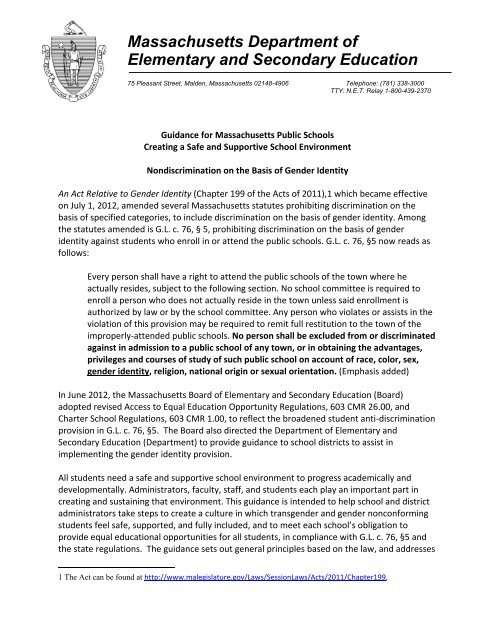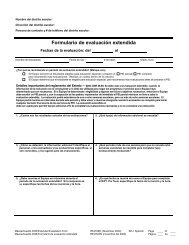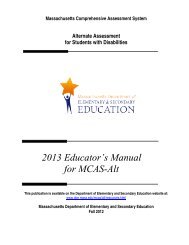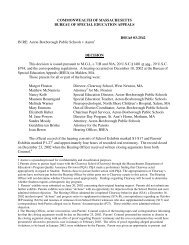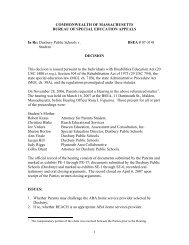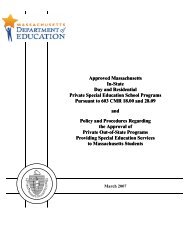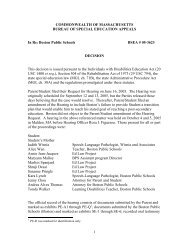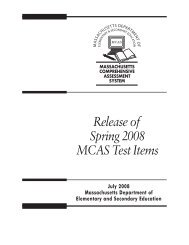Guidance for Massachusetts Public Schools Creating a Safe and ...
Guidance for Massachusetts Public Schools Creating a Safe and ...
Guidance for Massachusetts Public Schools Creating a Safe and ...
You also want an ePaper? Increase the reach of your titles
YUMPU automatically turns print PDFs into web optimized ePapers that Google loves.
<strong>Massachusetts</strong> Department of<br />
Elementary <strong>and</strong> Secondary Education<br />
75 Pleasant Street, Malden, <strong>Massachusetts</strong> 02148-4906 Telephone: (781) 338-3000<br />
TTY: N.E.T. Relay 1-800-439-2370<br />
<strong>Guidance</strong> <strong>for</strong> <strong>Massachusetts</strong> <strong>Public</strong> <strong>Schools</strong><br />
<strong>Creating</strong> a <strong>Safe</strong> <strong>and</strong> Supportive School Environment<br />
Nondiscrimination on the Basis of Gender Identity<br />
An Act Relative to Gender Identity (Chapter 199 of the Acts of 2011),1 which became effective<br />
on July 1, 2012, amended several <strong>Massachusetts</strong> statutes prohibiting discrimination on the<br />
basis of specified categories, to include discrimination on the basis of gender identity. Among<br />
the statutes amended is G.L. c. 76, § 5, prohibiting discrimination on the basis of gender<br />
identity against students who enroll in or attend the public schools. G.L. c. 76, §5 now reads as<br />
follows:<br />
Every person shall have a right to attend the public schools of the town where he<br />
actually resides, subject to the following section. No school committee is required to<br />
enroll a person who does not actually reside in the town unless said enrollment is<br />
authorized by law or by the school committee. Any person who violates or assists in the<br />
violation of this provision may be required to remit full restitution to the town of the<br />
improperly-attended public schools. No person shall be excluded from or discriminated<br />
against in admission to a public school of any town, or in obtaining the advantages,<br />
privileges <strong>and</strong> courses of study of such public school on account of race, color, sex,<br />
gender identity, religion, national origin or sexual orientation. (Emphasis added)<br />
In June 2012, the <strong>Massachusetts</strong> Board of Elementary <strong>and</strong> Secondary Education (Board)<br />
adopted revised Access to Equal Education Opportunity Regulations, 603 CMR 26.00, <strong>and</strong><br />
Charter School Regulations, 603 CMR 1.00, to reflect the broadened student anti-discrimination<br />
provision in G.L. c. 76, §5. The Board also directed the Department of Elementary <strong>and</strong><br />
Secondary Education (Department) to provide guidance to school districts to assist in<br />
implementing the gender identity provision.<br />
All students need a safe <strong>and</strong> supportive school environment to progress academically <strong>and</strong><br />
developmentally. Administrators, faculty, staff, <strong>and</strong> students each play an important part in<br />
creating <strong>and</strong> sustaining that environment. This guidance is intended to help school <strong>and</strong> district<br />
administrators take steps to create a culture in which transgender <strong>and</strong> gender noncon<strong>for</strong>ming<br />
students feel safe, supported, <strong>and</strong> fully included, <strong>and</strong> to meet each school’s obligation to<br />
provide equal educational opportunities <strong>for</strong> all students, in compliance with G.L. c. 76, §5 <strong>and</strong><br />
the state regulations. The guidance sets out general principles based on the law, <strong>and</strong> addresses<br />
1 The Act can be found at http://www.malegislature.gov/Laws/SessionLaws/Acts/2011/Chapter199,
common issues regarding transgender <strong>and</strong> gender noncon<strong>for</strong>ming students. It offers case<br />
studies based on experiences of schools <strong>and</strong> students in <strong>Massachusetts</strong>, <strong>and</strong> reflects the need<br />
to consider issues on a case-by-case basis. The list of issues is not exhaustive, <strong>and</strong> the examples<br />
are intended to be illustrative, not prescriptive.<br />
In preparing this guidance, the Department reviewed policies <strong>and</strong> guidance from several states,<br />
organizations, <strong>and</strong> athletic associations <strong>and</strong> consulted with the field. We appreciate the input<br />
we received from school <strong>and</strong> district administrators, advocacy groups, parents, students, <strong>and</strong><br />
other interested constituents.<br />
Definitions<br />
Underst<strong>and</strong>ing the terminology associated with gender identity is important to providing a safe<br />
<strong>and</strong> supportive school environment <strong>for</strong> students whose rights are protected under the law. The<br />
following terms appear in this document <strong>and</strong> are defined to assist in underst<strong>and</strong>ing the<br />
guidance presented. Although these are the most commonly used terms, students may prefer<br />
other terms to describe their gender identity, appearance, or behavior. The term “gender<br />
identity” is specifically defined in the Mass. General Laws, as amended by An Act Relative to<br />
Gender Identity (the gender identity law).<br />
The Law<br />
Gender expression: the manner in which a person represents or expresses gender to<br />
others, often through behavior, clothing, hairstyles, activities, voice, or mannerisms.<br />
Gender identity: as defined in part at G.L. c. 4, § 7, is “a person’s gender-related<br />
identity, appearance or behavior, whether or not that gender-related identity,<br />
appearance or behavior is different from that traditionally associated with the person’s<br />
physiology or assigned sex at birth...”<br />
Gender noncon<strong>for</strong>ming: a term used to describe people whose gender expression<br />
differs from stereotypic expectations. The terms “gender variant” or “gender atypical”<br />
are also used.<br />
Transgender: an umbrella term used to describe a person whose gender identity or<br />
gender expression is different from that traditionally associated with the assigned sex at<br />
birth.<br />
The gender identity law amended G.L. c. 76, § 5,2 to establish that no person shall be excluded<br />
from or discriminated against in admission to a public school of any town, or in obtaining the<br />
advantages, privileges <strong>and</strong> courses of study of such public school on account of gender identity,<br />
among other characteristics. The amended Access to Equal Educational Opportunity<br />
regulations, 603 CMR 26.00, <strong>and</strong> the non-discrimination provision of the Charter School<br />
2 The Act amends several other statutes as well, including G.L. c. 151B (governing nondiscrimination in<br />
employment), to prohibit discrimination on the basis of gender identity.
egulations, 603 CMR 1.00, require schools to establish policies <strong>and</strong> procedures, provide<br />
training, <strong>and</strong> implement <strong>and</strong> monitor practices to ensure that obstacles to equal access to<br />
school programs are removed <strong>for</strong> all students, including transgender <strong>and</strong> gender<br />
noncon<strong>for</strong>ming students.<br />
All districts <strong>and</strong> schools should review existing policies, h<strong>and</strong>books, <strong>and</strong> other written materials<br />
to ensure that they are updated to reflect the new law. At a minimum, this means including the<br />
category of “gender identity” within the identification of legally protected characteristics. For<br />
example:<br />
The [ ] <strong>Public</strong> <strong>Schools</strong> strives to provide a safe, respectful, <strong>and</strong> supportive learning<br />
environment in which all students can thrive <strong>and</strong> succeed in its schools. The [ ] <strong>Public</strong><br />
<strong>Schools</strong> prohibits discrimination on the basis of race, color, sex, gender identity, religion,<br />
national origin, or sexual orientation <strong>and</strong> ensures that all students have equal rights of<br />
access <strong>and</strong> equal enjoyment of the opportunities, advantages, privileges, <strong>and</strong> courses of<br />
study.<br />
The gender identity law reflects the reality that transgender <strong>and</strong> gender noncon<strong>for</strong>ming<br />
students are enrolled in <strong>Massachusetts</strong> public schools. These students, because of widespread<br />
misunderst<strong>and</strong>ing <strong>and</strong> lack of knowledge about their lives, are at a higher risk <strong>for</strong> peer<br />
ostracism, victimization, <strong>and</strong> bullying. The 2011 National School Climate Survey by the Gay,<br />
Lesbian & Straight Education Network (GLSEN), found that 75.4% of transgender students had<br />
been verbally harassed in the previous year, 32.1% had been physically harassed, <strong>and</strong> 16.8%<br />
had been physically assaulted. Educators play an essential role in advocating <strong>for</strong> the well-being<br />
of these students <strong>and</strong> creating a school culture that supports them.<br />
Underst<strong>and</strong>ing Gender Identity<br />
The gender identity law defines “gender identity” to mean “a person's gender-related identity,<br />
appearance or behavior, whether or not that gender-related identity, appearance or behavior is<br />
different from that traditionally associated with the person's physiology or assigned sex at<br />
birth.”3 The law also states that “[g]ender-related identity may be shown by providing<br />
evidence including, but not limited to, medical history, care or treatment of the gender-related<br />
identity, consistent <strong>and</strong> uni<strong>for</strong>m assertion of the gender-related identity or any other evidence<br />
that the gender-related identity is sincerely held as part of a person's core identity; provided,<br />
however, that gender-related identity shall not be asserted <strong>for</strong> any improper purpose.”4<br />
Transgender youth are those whose assigned birth sex does not match their internalized sense<br />
of their gender (their “gender-related identity”), <strong>and</strong> gender noncon<strong>for</strong>ming youth are those<br />
whose gender-related identity does not meet the stereotypically expected norms associated<br />
with their assigned sex at birth. A transgender boy, <strong>for</strong> example, is a youth who was assigned<br />
3 Mass. Gen. Laws. Ch. 4, § 7 (2012).<br />
4 Id.
the sex of female at birth but has a clear <strong>and</strong> persistent identity as male. A transgender girl is a<br />
youth who was assigned the sex of male at birth but has a clear <strong>and</strong> persistent identity as<br />
female. Gender noncon<strong>for</strong>ming youth range in the ways in which they identify as male, female,<br />
some combination of both, or neither.<br />
The responsibility <strong>for</strong> determining a student’s gender identity rests with the student or, in the<br />
case of young students not yet able to advocate <strong>for</strong> themselves, with the parent.5 One’s gender<br />
identity is an innate, largely inflexible characteristic of each individual’s personality that is<br />
generally established by age four, although the age at which individuals come to underst<strong>and</strong><br />
<strong>and</strong> express their gender identity may vary based on each person’s social <strong>and</strong> familial social<br />
development.6 As a result, the person best situated to determine a student’s gender identity is<br />
that student himself or herself.<br />
In one <strong>Massachusetts</strong> town, the parents of a pre-school-age biologically female child<br />
noted throughout the child’s early years that their child identified as a boy. For as long<br />
as the parents could remember, the child preferred to play with boys rather than girls,<br />
wanted a short haircut, rejected wearing any clothing that the child identified as<br />
“something a girl would wear,” <strong>and</strong> ignored anyone who called him by his stereotypically<br />
feminine name. When it was time <strong>for</strong> the child to enter kindergarten, the child said to<br />
his parents, “You have to tell them when I go to kindergarten that I’m a boy.”<br />
Consistent with the statutory st<strong>and</strong>ard, a school should accept a student’s assertion of his or<br />
her gender identity when there is “consistent <strong>and</strong> uni<strong>for</strong>m assertion of the gender-related<br />
identity, or any other evidence that the gender-related identity is sincerely held as part of a<br />
person’s core identity.” If a student’s gender-related identity, appearance, or behavior meets<br />
this st<strong>and</strong>ard, the only circumstance in which a school may question a student’s asserted<br />
gender identity is where school personnel have a credible basis <strong>for</strong> believing that the student’s<br />
gender-related identity is being asserted <strong>for</strong> some improper purpose.<br />
In most situations, determining a student’s gender identity is simple. A student who says she is<br />
a girl <strong>and</strong> wishes to be regarded that way throughout the school day <strong>and</strong> throughout every, or<br />
almost every, other area of her life, should be respected <strong>and</strong> treated like a girl. So too with a<br />
student who says he is a boy <strong>and</strong> wishes to be regarded that way throughout the school day<br />
<strong>and</strong> throughout every, or almost every, other area of his life. Such a student should be<br />
respected <strong>and</strong> treated like a boy.<br />
The statute does not require consistent <strong>and</strong> uni<strong>for</strong>m assertion of gender identity as long as<br />
there is “other evidence that the gender-related identity is sincerely held as part of [the]<br />
person’s core identity.” Many transgender people experience discrimination, <strong>and</strong> some<br />
5 When used in this document, the term “parent” refers to parent as well as legal guardian.<br />
6 See Gerald P. Mallon, “Practice with Transgendered Children,” in Social Services with Transgendered<br />
Youth 49, 55-58 (Gerald P. Mallon ed., 1999). See also Stephanie Brill & Rachel Pepper, “Developmental<br />
Stages <strong>and</strong> the Transgender Child,” in The Transgender Child, 61-64.
experience violence due to their status. Some environments may feel safe <strong>and</strong> inclusive, <strong>and</strong><br />
others less so, challenging a person’s ability to live consistently with one gender identity in all<br />
aspects of life. For example, it is possible that a biologically male student with a female gender<br />
identity who lives as a girl does not express her female gender identity all the time. In one case,<br />
such a student agreed to present as a boy when visiting relatives until the student’s parents<br />
could explain the student’s transgender identity to them. The fact that the student did not<br />
exclusively assert her female identity did not alter the fact that she had a female gender<br />
identity.<br />
Confirmation of a student’s asserted gender identity may include a letter from a parent, health<br />
care provider, school staff member familiar with the student (a teacher, guidance counselor, or<br />
school psychologist, among others), or other family members or friends. A letter from a social<br />
worker, doctor, nurse practitioner, or other health care provider stating that a student is being<br />
provided medical care or treatment relating to her/his gender identity is one <strong>for</strong>m of<br />
confirmation of an asserted gender identity. It is not, however, the exclusive <strong>for</strong>m upon which<br />
the school or student may rely. A letter from a clergy member, coach, family friend, or relative<br />
stating that the student has asked to be treated consistent with her/his asserted gender<br />
identity, or photographs at public events or family gatherings, are other potential <strong>for</strong>ms of<br />
confirmation. These examples are intended to be illustrative rather than comprehensive.<br />
In one <strong>Massachusetts</strong> middle school, a biologically male student explained to her<br />
guidance counselor that she was a transgender girl who expressed her female gender<br />
identity only at home. The stress associated with having to hide her female gender<br />
identity at school was having a negative impact on her mental health, as well as on her<br />
academic per<strong>for</strong>mance. The student <strong>and</strong> her parents asked if it would be okay if she<br />
expressed her female gender identity at school. The guidance counselor assured the<br />
student <strong>and</strong> her parents that she could do so. The fact that the student presented no<br />
documentation to support her gender identity was not a concern since the school had no<br />
reason to believe the request was based on anything other than a sincerely held belief<br />
that she had a female gender identity.<br />
Gender Transition<br />
Many, though not all, transgender youth undergo the experience of gender transition. The<br />
term “gender transition” describes the experience by which a person goes from living <strong>and</strong><br />
identifying as one gender to living <strong>and</strong> identifying as another. For most youth, <strong>and</strong> <strong>for</strong> all young<br />
children, the experience of gender transition involves no medical intervention. Rather, most<br />
transgender youth will undergo gender transition through a process commonly referred to as<br />
“social transition,” whereby they begin to live <strong>and</strong> identify as the gender consistent with their<br />
gender-related identity. Some transgender youth who are close to reaching puberty, or after<br />
commencing puberty, may complement social transition with medical intervention that may<br />
include hormone suppressants, cross-gender hormone therapy, <strong>and</strong>, <strong>for</strong> a small number of<br />
young people, a range of gender-confirming surgeries. The decision about whether <strong>and</strong> how to
undergo gender transition is personal <strong>and</strong> depends on the unique circumstances of each<br />
individual. There is no threshold medical or mental health diagnosis or treatment requirement<br />
that any student must meet in order to have his or her gender identity recognized <strong>and</strong><br />
respected by a school.<br />
Some transgender <strong>and</strong> gender noncon<strong>for</strong>ming students are not openly so at home <strong>for</strong> reasons<br />
such as safety concerns or lack of acceptance. School personnel should speak with the student<br />
first be<strong>for</strong>e discussing a student’s gender noncon<strong>for</strong>mity or transgender status with the<br />
student’s parent or guardian. For the same reasons, school personnel should discuss with the<br />
student how the school should refer to the student, e.g., appropriate pronoun use, in written<br />
communication to the student’s parent or guardian.<br />
Names <strong>and</strong> Pronouns<br />
The issue of the name <strong>and</strong> pronoun to use in referring to a transgender student is one of the<br />
first that schools must resolve to create an environment in which that student feels safe <strong>and</strong><br />
supported. Transgender students often choose to change the name assigned to them at birth<br />
to a name that is associated with their gender identity. As with most other issues involved with<br />
creating a safe <strong>and</strong> supportive environment <strong>for</strong> transgender students, the best course is to<br />
engage the student, <strong>and</strong> in the case of a younger student, the parent, with respect to name <strong>and</strong><br />
pronoun use, <strong>and</strong> agree on a plan to initiate that name <strong>and</strong> pronoun use within the school. The<br />
plan also could include when <strong>and</strong> how this is communicated to students <strong>and</strong> their parents. In<br />
the case of a transgender student who is enrolling at a new school, it is important that the<br />
school respect the student’s privacy (see the following section) <strong>and</strong> chosen name.<br />
In one situation where a transgender girl was entering high school, she <strong>and</strong> her parent<br />
asked the principal to in<strong>for</strong>m her teachers that even though her school records indicate<br />
that her name is John, she goes by the name Jane <strong>and</strong> uses female pronouns. The school<br />
principal sent the following memor<strong>and</strong>um to the student’s classroom teachers: “The<br />
student John Smith wishes to be referred to by the name Jane Smith, a name that is<br />
consistent with the student’s female gender identity. Please be certain to use the<br />
student’s preferred name in all contexts, as well as the corresponding pronouns. It is my<br />
expectation that students will similarly refer to the student by her chosen name <strong>and</strong><br />
preferred pronouns. Your role modeling will help make a smooth transition <strong>for</strong> all<br />
concerned. If students do not act accordingly, you may speak to them privately after<br />
class to request that they do. Continued, repeated, <strong>and</strong> intentional misuse of names <strong>and</strong><br />
pronouns may erode the educational environment <strong>for</strong> Jane. It should not be tolerated<br />
<strong>and</strong> can be grounds <strong>for</strong> student discipline. If you need any assistance to make sure that<br />
Jane Smith experiences a safe, nondiscriminatory classroom atmosphere, please contact<br />
me or Ms. O’Neill. – Mr. Jones, Principal.”
<strong>Massachusetts</strong>’ law recognizes common law name changes. An individual may adopt a name<br />
that is different from the name that appears on his or her birth certificate provided the change<br />
of name is done <strong>for</strong> an honest reason, with no fraudulent intent. Nothing more <strong>for</strong>mal than<br />
usage is required.7 Hence, when requested, schools should accurately record the student’s<br />
chosen name on all records, whether or not the student, parent, or guardian provides the<br />
school with a court order <strong>for</strong>malizing a name change.<br />
The Department has a procedure in place to update name changes <strong>and</strong> gender markers in the<br />
Student In<strong>for</strong>mation Management System (SIMS) upon request. The document Assigning State<br />
Assigned Student Identifiers (SASIDs) to <strong>Massachusetts</strong>’ <strong>Public</strong> School Students, which may be<br />
found at http://www.doe.mass.edu/infoservices/data/sims/sasid/, guides schools through<br />
changing names <strong>and</strong> gender markers on school records.<br />
In sum, school personnel should use the student’s chosen name <strong>and</strong> pronouns appropriate to a<br />
student’s gender identity, regardless of the student’s assigned birth sex. For those students<br />
who have been attending a school <strong>and</strong> undergo gender transition while attending the same<br />
school, it is important to develop a plan <strong>for</strong> initiating use of the chosen name <strong>and</strong> pronouns<br />
consistent with the student’s gender identity.<br />
Privacy, Confidentiality, <strong>and</strong> Student Records<br />
Under state law, in<strong>for</strong>mation about a student’s assigned birth sex, name change <strong>for</strong> gender<br />
identity purposes, gender transition, medical or mental health treatment related to gender<br />
identity, or any other in<strong>for</strong>mation of a similar nature, regardless of its <strong>for</strong>m, is part of the<br />
individual’s student record (see <strong>Massachusetts</strong> Student Records Regulations, 603 CMR 23.00), is<br />
confidential, <strong>and</strong> must be kept private <strong>and</strong> secure, except in limited circumstances. 603 CMR §<br />
23.04.8 One circumstance is when authorized school personnel require the in<strong>for</strong>mation to<br />
provide administrative, teaching, counseling, or other services to the student in the<br />
per<strong>for</strong>mance of their official duties. For transgender students, authorized school personnel<br />
could include individuals such as the principal, school nurse, classroom teacher(s), or guidance<br />
or adjustment counselor.<br />
When a student new to a school is using a chosen name, the birth name is considered private<br />
in<strong>for</strong>mation <strong>and</strong> may be disclosed only with authorization as provided under the <strong>Massachusetts</strong><br />
Student Records Regulations. If the student has previously been known at school or in school<br />
records by his or her birth name, the principal should direct school personnel to use the<br />
student’s chosen name. Every ef<strong>for</strong>t should be made to update student records (<strong>for</strong> example,<br />
Individualized Education Programs) with the student’s chosen name <strong>and</strong> not circulate records<br />
with the student’s assigned birth name. Records with the student’s assigned birth name should<br />
7 For certain transactions, such as banking <strong>and</strong> applying <strong>for</strong> governmental benefits or licenses, it may be necessary<br />
to have a <strong>for</strong>mal legal document establishing one’s change of name <strong>for</strong> identity <strong>and</strong> other purposes.<br />
8 The federal Family Educational Rights <strong>and</strong> Privacy Act, 20 USC 1232g, also protects the privacy of education<br />
records <strong>and</strong> requires that personally identifiable in<strong>for</strong>mation be kept secure <strong>and</strong> confidential.
e kept in a separate, confidential file.<br />
One school nurse dealt with in<strong>for</strong>mation in the student’s file by starting a new file with<br />
the student’s chosen name, entered previous medical in<strong>for</strong>mation (<strong>for</strong> example,<br />
immunizations) under the student’s chosen name, <strong>and</strong> created a separate, confidential<br />
folder that contained the student’s past in<strong>for</strong>mation <strong>and</strong> birth name.<br />
When determining which, if any, staff or students should be in<strong>for</strong>med that a student’s gender<br />
identity is different from the assigned birth sex, decisions should be made in consultation with<br />
the student, or in the case of a young student, the student’s parent or guardian. The key<br />
question is whether <strong>and</strong> how sharing the in<strong>for</strong>mation will benefit the student.<br />
In one case, parents of a transgender male-to-female elementary school student<br />
requested that only the school principal <strong>and</strong> the school nurse be aware that the student<br />
was assigned the sex of male at birth. After a discussion with the school principal, the<br />
parents agreed that the student’s teacher, the school secretary, <strong>and</strong> the district<br />
superintendent would also be in<strong>for</strong>med. In this situation, the school principal kept the<br />
student’s birth certificate in a separate, locked file that only the principal could access,<br />
<strong>and</strong> put a note in the student’s other file saying that the principal had viewed the<br />
student’s birth certificate. In another situation, where a biological male came to school<br />
after April vacation as a girl, the school principal <strong>and</strong> guidance counselor, in<br />
collaboration with the student <strong>and</strong> her parents, developed a plan <strong>for</strong> communicating<br />
in<strong>for</strong>mation regarding the student’s transition to staff, parents, <strong>and</strong> students. The plan<br />
included who was going to say what to whom, <strong>and</strong> when the communication would take<br />
place.<br />
Transgender <strong>and</strong> gender noncon<strong>for</strong>ming students may decide to discuss <strong>and</strong> express their<br />
gender identity openly <strong>and</strong> may decide when, with whom, <strong>and</strong> how much to share private<br />
in<strong>for</strong>mation. A student who is 14 years of age or older, or who has entered the ninth grade,<br />
may consent to disclosure of in<strong>for</strong>mation from his or her student record. If a student is under<br />
14 <strong>and</strong> is not yet in the ninth grade, the student’s parent (alone) has the authority to decide on<br />
disclosures <strong>and</strong> other student record matters. 9<br />
Gender Markers on Student Records<br />
A gender marker is the designation on school <strong>and</strong> other records that indicates a student’s<br />
gender. For most students, records that include an indication of a student’s gender will reflect<br />
a student’s assigned birth sex. For transgender students, however, a documented gender<br />
marker (<strong>for</strong> example, “male” or “female” on a permanent record) should reflect the student’s<br />
9 See 603 CMR §§23.01 <strong>and</strong> 23.07. If a student is from 14 through 17 years of age or has entered ninth grade, both<br />
the parent <strong>and</strong> the student may make decisions concerning the student record, or either the student or the parent<br />
acting alone may decide.
gender identity, not the student’s assigned sex. This means that if a transgender student whose<br />
gender identity is male has a school record that reflects an assigned birth sex as female, then<br />
upon request by the student or, in the case of young students not yet able to advocate <strong>for</strong><br />
themselves, by the parent or guardian, the school should change the gender marker on the<br />
record to male.10 <strong>Schools</strong> are advised to collect or maintain in<strong>for</strong>mation about students’<br />
gender only when necessary.<br />
One school reviewed the documentation requests it sent out to families <strong>and</strong> noticed that<br />
field trip permission <strong>for</strong>ms included a line to fill in indicating the student’s gender. Upon<br />
consideration, the school determined that the requested in<strong>for</strong>mation was irrelevant to<br />
the field trip activities <strong>and</strong> deleted the line with the gender marker request.<br />
In addition, transgender students who transition after having completed high school, may ask<br />
their previous schools to amend school records or a diploma or transcript that include the<br />
student’s birth name <strong>and</strong> gender. When requested, <strong>and</strong> when satisfied with the gender<br />
identity in<strong>for</strong>mation provided, schools should amend the student’s record, including reissuing a<br />
high school diploma or transcript, to reflect the student’s current name <strong>and</strong> gender.<br />
Restrooms, Locker Rooms, <strong>and</strong> Changing Facilities<br />
All students are entitled to have access to restrooms, locker rooms <strong>and</strong> changing facilities that<br />
are sanitary, safe, <strong>and</strong> adequate, so they can com<strong>for</strong>tably <strong>and</strong> fully engage in their school<br />
program <strong>and</strong> activities. In meeting with the transgender student (<strong>and</strong> parent) to discuss the<br />
issues set <strong>for</strong>th in this memor<strong>and</strong>um, it is essential that the principal <strong>and</strong> student address the<br />
student’s access to the restrooms, locker room <strong>and</strong> changing facility. Each situation needs to<br />
be reviewed <strong>and</strong> addressed based on the particular circumstances of the student <strong>and</strong> the<br />
school facilities. In all cases, the principal should be clear with the student (<strong>and</strong> parent) that the<br />
student may access the restroom, locker room, <strong>and</strong> changing facility that corresponds to the<br />
student’s gender identity. While some transgender students will want that arrangement,<br />
others will not be com<strong>for</strong>table with it. Transgender students who are uncom<strong>for</strong>table using a<br />
sex-segregated restroom should be provided with a safe <strong>and</strong> adequate alternative, such as a<br />
single “unisex” restroom or the nurse’s restroom. Similarly, some transgender students may<br />
not be com<strong>for</strong>table undressing in the changing facilities that correspond to the student’s<br />
gender identity. The following are examples of ways in which school officials have responded to<br />
these situations:<br />
In one elementary school, a transgender second-grader socially transitioned from female<br />
to male. The principal in<strong>for</strong>med the staff: For the remainder of this year, he will use<br />
Nurse Margaret’s restroom, <strong>and</strong> toward the end of the year we will make future<br />
10 As discussed in the section on Names <strong>and</strong> Pronouns, the Department’s publication Assigning State Assigned<br />
Student Identifiers (SASIDs) to <strong>Massachusetts</strong>’ <strong>Public</strong> School Students guides district staff through the process of<br />
adding or revising SIMS data.
determinations of restroom use in consultation with his family.<br />
In one middle school, a male-to-female transgender sixth-grader socially transitioned<br />
after spring break. For the rest of the school year, she used the nurse’s restroom <strong>and</strong> the<br />
other unisex restrooms at the school. Beginning in seventh grade, she used the girls’ restroom.<br />
In one high school, a transgender male-to-female student was given access to the female<br />
changing facility, but the student was uncom<strong>for</strong>table using the female changing facility<br />
with other female students because there were no private changing areas within the<br />
facility. The principal examined the changing facility <strong>and</strong> determined that curtains could<br />
easily be put up along one side of a row of benches near the group lockers, providing<br />
private changing areas <strong>for</strong> any students who wished to use them. After the school put<br />
up the curtains, the student was com<strong>for</strong>table using the changing facility.<br />
Some students may feel uncom<strong>for</strong>table with a transgender student using the same sexsegregated<br />
restroom, locker room or changing facility. This discom<strong>for</strong>t is not a reason to deny<br />
access to the transgender student. School administrators <strong>and</strong> counseling staff should work with<br />
students to address the discom<strong>for</strong>t <strong>and</strong> to foster underst<strong>and</strong>ing of gender identity, to create a<br />
school culture that respects <strong>and</strong> values all students.<br />
The Department strongly recommends that districts include an appropriate number of genderneutral<br />
restrooms commensurate with the size of the school, <strong>and</strong> at least one gender-neutral<br />
changing facility, into the design of new schools <strong>and</strong> school renovations.<br />
School staff as well as students <strong>and</strong> their families may find the use of restrooms <strong>and</strong> changing<br />
facilities to be among the more challenging issues presented by the gender identity law,<br />
perhaps due to issues of personal privacy. As emphasized in other sections of this guidance,<br />
these issues should be resolved on a case-by-case basis, through dialogue with students <strong>and</strong><br />
parents, <strong>and</strong> through leadership in creating safe <strong>and</strong> supportive learning environments.<br />
Physical Education Classes <strong>and</strong> Intramural <strong>and</strong> Interscholastic Athletic Activities<br />
Physical education is a required course in all grades in <strong>Massachusetts</strong>’ public schools, <strong>and</strong><br />
school-based athletics are an important part of many students’ lives. Most physical education<br />
classes in <strong>Massachusetts</strong>’ schools are coed, so the gender identity of students should not be an<br />
issue with respect to these classes. Where there are sex-segregated classes or athletic activities,<br />
including intramural <strong>and</strong> interscholastic athletics, all students must be allowed to participate in<br />
a manner consistent with their gender identity. With respect to interscholastic athletics, the<br />
<strong>Massachusetts</strong> Interscholastic Athletic Association will rely on the gender determination made<br />
by the student’s district; it will not make separate gender identity determinations.<br />
At one school, a transgender girl joined the girls’ cheerleading squad. The school<br />
supported the student’s participation on the team. When the team was going to a<br />
regional competition, however, several of the team members raised a concern that the
school would be made to compete in the coed cheerleading portion of the competition<br />
rather than in the all-girls portion <strong>for</strong> which they prepared. With the permission of the<br />
student, the principal wrote a letter that she gave to the coach to take to the<br />
competition in case officials at the competition questioned the team’s participation in<br />
the all-girls’ portion of the event. The letter explained: “Student, Jane Smith, is a<br />
transgender girl who has been a member of the girls’ team since (date). Jane has a<br />
sincerely held female gender identity <strong>and</strong>, there<strong>for</strong>e, according to state law must be<br />
permitted to participate as a girl on the girls’ cheerleading team.” The team<br />
participated in the regional competition without incident.<br />
Other Gender-Based Activities, Rules, Policies, <strong>and</strong> Practices<br />
As a general matter, schools should evaluate all gender-based policies, rules, <strong>and</strong> practices <strong>and</strong><br />
maintain only those that have a clear <strong>and</strong> sound pedagogical purpose. Gender-based policies,<br />
rules, <strong>and</strong> practices can have the effect of marginalizing, stigmatizing, <strong>and</strong> excluding students,<br />
whether they are gender noncon<strong>for</strong>ming or not. In some circumstances, these policies, rules,<br />
<strong>and</strong> practices may violate federal <strong>and</strong> state law. For these reasons, schools should consider<br />
alternatives to them.<br />
Whenever students are separated by gender in school activities or are subject to an otherwise<br />
lawful gender-specific rule, policy, or practice, students must be permitted to participate in<br />
such activities or con<strong>for</strong>m to such rule, policy, or practice consistent with their gender identity.<br />
The new law on gender identity provides a good opportunity <strong>for</strong> schools to review their genderdistinct<br />
policies. For example, some schools require students to wear gender-based garb <strong>for</strong><br />
graduation or have gender-based dress codes <strong>for</strong> prom, special events, <strong>and</strong> daily attire. <strong>Schools</strong><br />
should eliminate gendered policies <strong>and</strong> practices such as these. For example, one school that<br />
previously had blue graduation gowns <strong>for</strong> boys <strong>and</strong> white ones <strong>for</strong> girls switched to blue gowns<br />
<strong>for</strong> all graduates. The school also changed its gender-based dress code <strong>for</strong> the National Honor<br />
Society ceremony, which had required girls to wear dresses.<br />
Similarly, some classroom teachers may routinely include gender-based practices in the<br />
classroom. For example, some teachers may have boys <strong>and</strong> girls line up separately to leave the<br />
classroom to go to lunch, the gymnasium, restrooms, or recess, <strong>and</strong> may never have considered<br />
the educational value of non-gendered alternatives, such as having students line up in the order<br />
of their birthdays, or alphabetically by name, or in the order in which they are sitting.11<br />
11 Gender <strong>and</strong> Children: A Place to Begin <strong>for</strong> Educators www.welcomingschools.org
Education <strong>and</strong> Training<br />
In order to further a safe <strong>and</strong> supportive school environment <strong>for</strong> all students, schools should<br />
incorporate education <strong>and</strong> training about transgender <strong>and</strong> gender noncon<strong>for</strong>ming students into<br />
their anti-bullying curriculum, student leadership trainings, <strong>and</strong> staff professional development.<br />
As with other ef<strong>for</strong>ts to promote a positive school culture, it is important that student leaders<br />
<strong>and</strong> school personnel, particularly school administrators, become familiar with the gender<br />
identity law, regulations, guidance, <strong>and</strong> related resources, <strong>and</strong> that they communicate <strong>and</strong><br />
model respect <strong>for</strong> the gender identity of all students.<br />
Professional development <strong>for</strong> school staff could include topics on gender identity <strong>and</strong> gender<br />
noncon<strong>for</strong>mity such as: the <strong>Massachusetts</strong> Student Anti-discrimination Law <strong>and</strong> Regulations;<br />
the ESE <strong>Guidance</strong> on Notifying Parents When a Student Has Been Bullied Based on Sexual<br />
Orientation or Gender Identity/Expression; key terms related to gender identity <strong>and</strong> expression;<br />
the development of gender identity; the experiences of transgender <strong>and</strong> other gender<br />
noncon<strong>for</strong>ming students; risk <strong>and</strong> resilience data regarding transgender <strong>and</strong> gender<br />
noncon<strong>for</strong>ming students; ways to support transgender students <strong>and</strong> to improve the school<br />
climate <strong>for</strong> gender noncon<strong>for</strong>ming students; gender-neutral language <strong>and</strong> practices; <strong>and</strong> this<br />
guidance.<br />
Communication with School Community <strong>and</strong> Families<br />
Superintendents <strong>and</strong> principals need to review existing policies, h<strong>and</strong>books, <strong>and</strong> other written<br />
materials to ensure that they are updated to reflect the inclusion of gender identity in the<br />
student antidiscrimination law, <strong>and</strong> may wish to in<strong>for</strong>m all members of the school community,<br />
including school personnel, students, <strong>and</strong> families, of the recent change to state law <strong>and</strong> its<br />
implications <strong>for</strong> school policy <strong>and</strong> practice. This could take the <strong>for</strong>m of a letter that states the<br />
school’s commitment to being a supportive, inclusive environment <strong>for</strong> all students, as well as<br />
the school’s legal obligation to provide equal educational opportunities <strong>for</strong> all students. Such a<br />
letter might include the definitions provided at the beginning of this document <strong>and</strong> some basic<br />
in<strong>for</strong>mation about transgender <strong>and</strong> gender noncon<strong>for</strong>ming youth; a link to the school’s antibullying<br />
<strong>and</strong> anti-harassment policies; a link to this guidance; <strong>and</strong> other resources, including<br />
individuals to contact with additional questions. 12<br />
12 For example, a letter from one principal explained: “All people have a gender identity. For most<br />
people, their gender identity matches their assigned sex at birth. For transgender people, that is not the<br />
case. Transgender girls are individuals who were assigned the male sex at birth but whose lived<br />
experience of who they are is female. Transgender boys are individuals who were assigned the female<br />
sex at birth but whose lived experience of who they are is male. As a school community, we want to<br />
provide a safe environment <strong>and</strong> support all of our students so they can achieve academically. That<br />
means making sure that our school’s policies <strong>and</strong> practices are inclusive <strong>and</strong> respectful of all students,<br />
including transgender students. Toward that end, we have …[describe steps taken to implement the<br />
law].”
Conclusion<br />
This guidance cannot anticipate every situation in which questions may come up in the<br />
implementation of this law, <strong>and</strong> the needs of each transgender or gender noncon<strong>for</strong>ming<br />
student should be assessed <strong>and</strong> addressed on a case-by-case basis. The Department will<br />
continue to provide assistance, support, <strong>and</strong> resources as we work together to create a safe<br />
<strong>and</strong> supportive school environment <strong>for</strong> all students.<br />
For further in<strong>for</strong>mation or questions about the content of this guidance, please contact Center<br />
<strong>for</strong> Student Support @ ssca@doe.mass.edu.


